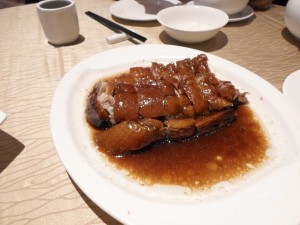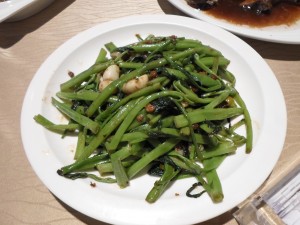I know that whenever I need some material for a post, I can always turn to something I’ve recently eaten. As any regular reader should know by now, there are all sorts of culinary adventures available for a foreigner in China. Recently, a friend of Rachelle’s and mine invited us out for an authentic Cantonese dinner at 炳胜(bing3 sheng4) restaurant across the street from the TaiKoo Hui shopping center.
We were going to take the B9 bus there, which uses Guangzhou’s BRT system–basically a highway for buses that cuts through the city and carries up to a million passengers a day. But apparently they had changed their plans and the one bus that stopped by was only going as far as Zhujiang New Town, so we gave up before the rain started falling too hard and took the metro, because hey, why not get packed in a rolling tin can like sardines.
We found the place rather easily, and our friend arrived shortly after. We let him make most of the choices, since we’re still not exactly experts on Cantonese cuisine, and in fact we can’t even speak Cantonese. Oh well.
In true Cantonese fashion, the dishes arrived as they were ready. We started out with some Pu’er tea, and marinated lotus root slices.

This tea comes from a particular part of Yunnan province and is fermented extensively, sometimes for decades. I don’t think our tea was quite that old, though. It is supposed to help digestion, especially of fatty or oily foods, and it had a delightful earthy taste. The lotus root marinade complemented it nicely, actually. For those who haven’t had lotus root before, it’s crispy and a little slippery and reminds me at least of a mix between water chestnut and raw potato. It’s also full of little holes, as you can see. Water plants love being hollow.
Next, the soup course.

So this soup had starfruit and papaya and pork. It was sweet and savory and quite good, although I didn’t end up finishing it before the next dish came out…

THE GOOSE. Rachelle and I love Cantonese goose. It took me a little while to be able to bite through the crispy skin, the layer of fat, and the meat all at once while still working around the bones (of course there’s bone, silly) and I still can’t not use my fingers a little to maneuver it around in my mouth, but still. Yum. You know, after that I could go for something lighter, maybe a vegetable or someth–

TA-DAA, MOTHERFUCKER!
This veggie is called 通菜(tong1cai4), and in English has a few names, most commonly called water spinach. Here is is sauteed with garlic. I will keep an eye out for this one in the market.

This is three flavors of tofu, in sauce, and topped with beef and shrimp and whatnot. I didn’t notice a very strong difference in the flavors, although they all were good. Rachelle noted some differences, and said the dark one in the middle was kind of earthy and tea-like. This tofu was a lot creamier than the kind I usually get in the market, almost custard-like.

In Cantonese cuisine, chicken is done a little differently from how you might know it. First off, the head is often staring at you. It’s also very lightly seasoned, if at all. Cantonese cuisine is all about the natural flavors of components, and so on. Sometimes this leads to terribly bland foods, but the natural taste of a chicken that isn’t stuck in a battery cage and fattened with corn and chemicals is actually quite delicious. This actually came with a little bowl of garlic dipping sauce, which was also great, but I mostly ate it plain. By this point, I was pretty sure that was all there was to the meal.

But then the pork arrived. And wow. It had a lot of fat, which is a feature it took me a while to get used to in food around here, but once you get used to it, you can enjoy food like this. The glaze on it was sticky, and slightly sweet, and just…well it made me happy to eat it. Okay. That was the meal.
Wait, dessert.

This is a pumpkin soup. There’s some stuff we think is tapioca on top. It was a perfect end to the meal.
Fuck yeah. Also, that’s another person we’re gonna make enchiladas for.















































































